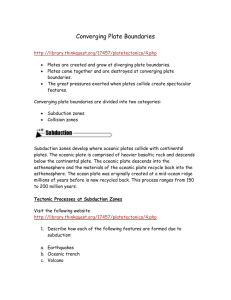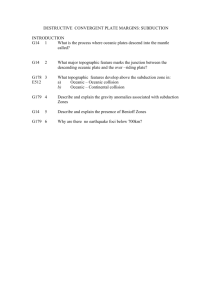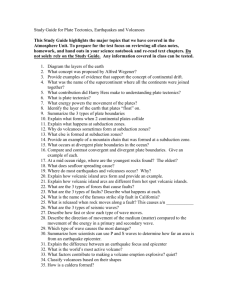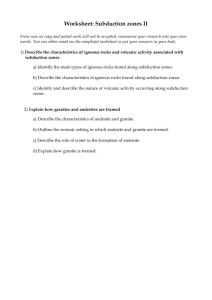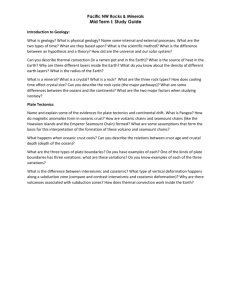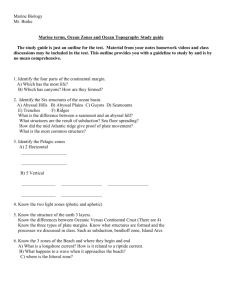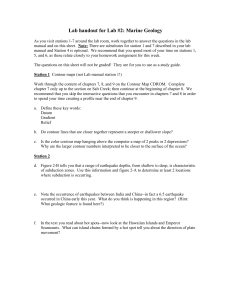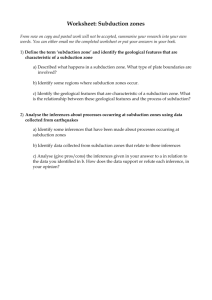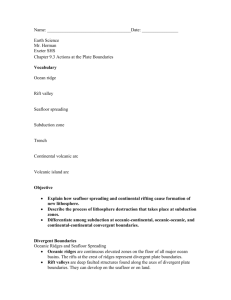DESTRUCTIVE CONVERGENT PLATE MARGINS: SUBDUCTION
advertisement
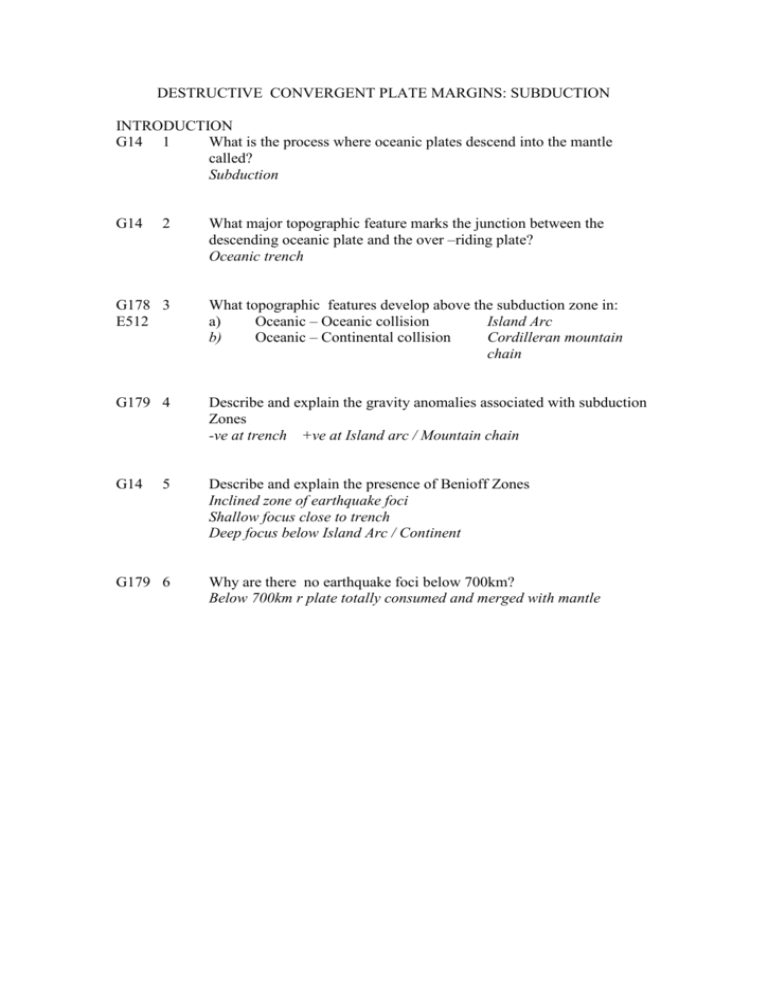
DESTRUCTIVE CONVERGENT PLATE MARGINS: SUBDUCTION INTRODUCTION G14 1 What is the process where oceanic plates descend into the mantle called? Subduction G14 2 What major topographic feature marks the junction between the descending oceanic plate and the over –riding plate? Oceanic trench G178 3 E512 What topographic features develop above the subduction zone in: a) Oceanic – Oceanic collision Island Arc b) Oceanic – Continental collision Cordilleran mountain chain G179 4 Describe and explain the gravity anomalies associated with subduction Zones -ve at trench +ve at Island arc / Mountain chain G14 Describe and explain the presence of Benioff Zones Inclined zone of earthquake foci Shallow focus close to trench Deep focus below Island Arc / Continent 5 G179 6 Why are there no earthquake foci below 700km? Below 700km r plate totally consumed and merged with mantle IGNEOUS PROCESSES AT SUBDUCTION ZONES G63 1 What material is subducted with the oceanic crust? Water in vesicles and between pillows and dykes Wet sediments G63 2 Explain 5 reasons why partial melting and the generation of magmas occurs in subduction zones. 1 Water lowers melting point of rocks 2 Friction and seismic activity in Benioff zone generate heat 3 Descending slab heated by conduction from hot mantle 4 Increasing ‘C and pressure with depth dehydrates oceanic slab, releasing volatiles into the overlying mantle wedge 5 Phase change to higher density minerals at depth releases heat GS179 E512 3 At what depth are magmas generated in the subduction zone? 100- 200km G63 Why do magmas produced at subduction zones not have the same compositions the original basaltic rocks of the oceanic crust? Partial melting: lowest ‘C of melting minerals 4 G179 5 What sequence of magma compositions is found after initial subduction and why? Diorite – Granodiorite – Granite Partial melting of early formed diorites G63-4 6 What is the relative sense of movement between subducting and overriding plates? Subducting plate moves, over-riding plate stationary G64 7 How and why does the composition of magmas generated at subduction zones change with time? Increasing silica Magma rises through same zone of over-riding plate Progressive heating Addition to magma by partial melting / removal by crystallisation G64 8 What rock type is characteristic of volcanic island arcs parallel to oceanic trenches? Andesite – Intermediate G64 9 Why are andesites described as an ‘irreversible addition to continental crust’? Low density – cannot be subducted Island arcs collide to form mini-continents Accretion forms continents G64 10 How long does continental crust take to form? 20 million years to produce 30km thickness of continental crust Africa + Asia 1000million years G64 11 Why is volcanism above subduction zones usually explosive? Silica rich – viscous – traps dissolved gases – explosive eg St Helens G64 12 What are volcaniclastic / pyroclastic / tephra rocks? Fragmental volcanic rocks produced by explosive eruptions G64 13 What shape / type of volcano do pyroclastics form? Conical composite volcanoes 14 How does the size of pyroclastic material change with increasing distance from the vent? Smaller G64 15 What are nuess ardentes / pyroclastic flows and what deposits do the produce? Cloud of hot gas and ash flowing fast down side of volcano following collapse of ash plume – deposit ash and welded tuff – ignimbrite pumice G65 16 Copy fig 4.16 METAMORPHIC PROCESSES AT SUBDUCTION ZONES G134 1 E512 Paired metamorphic belts are typical l associated with subduction Zones. Describe the temperature and pressure conditions and metamorphic facies that are produced in the metamorphic belt close to the oceanic trench. Low geothermal gradient / high tectonic forces Low temperature / High pressure metamorphism Blueschist facies rocks Blue due to Na rich amphibole Glaucophane E512 2 How does blueschist facies metamorphism lead to further magma genberation above the subduction zone? Metamorphism releases water into overlying asthenosphere Increases partial melting above descending slab E512 3 Describe the temperature and pressure conditions and 3 metamorphic facies associated with rising magma causing metamorphism of igneous rocks above subduction zones High temperature Low pressure Increasing temperature: Greenschist – Amphibolite – Granulite E513 4 Describe the paired metamorphic belts found on the Californian coast and Sierra Nevada and explain their interpretation. Californian coast Melange Lo temp Hi press W Sierra Nevada Magmatism Hi temp Lo press E Pacific plate moving E to be subducted under American plate SEDIMENTARY PROCESSES AT SUBDUCTION ZONES E289 1 What type of deposition is typical of deep ocean trenches? Thick Turbidites E512 2 Why are these sediments often intensely deformed? Low density – not subducted Crumpled, folded, scraped off subducting oceanic crust Plastered against edge of over-riding plate E281 3 Copy fig 11.33 E512 4 What term is used to describe the intensely deformed sediments found at subduction zones? Melange CONVERGENT PLATE BOUNDARIES CONTINENT –CONTINENT COLLISION: OROGENY G142 1 What happens to sediments on the continental shelf in continentcontinent collision? Faulted, folded, uplifted G142 2 Give an example of where this has happened India and Asia collide – Himalayas G144 3 What type of deformation is dominant at shllow depths in these regions and why? Brittle fracture – Thrust faults – cool G144 4 What type of deformation is dominant at greater depths in these regions and why? Ductile deformation: folding – hotter Tight isoclinal folding, nappes G144 5 What grade of metamorphism is commonly associated with nappes? High grade regional E515 6 Describe the Wilson cycle of plate tectonics Opening of ocean basins by sea floor spreading – closure of ocean – continent continent collision – formation of intracontinental orogenic mountain belt
